AMERICAN
COCKER SPANIEL
Judging
the American Cocker Spaniel: The Head
 A good head |
The
breed standard (AKC - 1992)
|
Standard
interpretation
|
| HEAD: To attain a well-proportioned head, which must be in balance with the rest of the dog, it embodies the following: | The head should be in proportion to the rest of the body - neither too small nor too large. You want to look for refinement in the fine chiselling, but the head should not tend towards Toy prettiness. Essentially, the Cocker is a working breed, so it should look as though it can carry a fair-sized bird. | |
| Expression: The expression is intelligent, alert, soft and appealing. | The soft, appealing expression is what sets this little dog apart from other Spaniels, other dogs. In all, there should be a pleasing balance of all elements to create a sense of rightness and quality. | |
| Eyes: Eyeballs are round and full, and look directly forward. The shape of the eye rims gives a slightly almond-shaped appearance, the eye is not weak or goggled. The colour of the iris is dark brown and, in general, the darker the better. | Look for beautiful, expressive eyes with a "chocolate-box" appeal. The eyes are full and almond-shaped - as dark as possible - and placed just either side of the side tips of the nose. Eye rims should be tight and darkly pigmented. | |
| Ears: Lobular, long, of fine leather, well feathered, and placed no higher than a line to the lower part of the eye. | The requirements are quite clear - the ears may not be set higher than the level of the eyes. The ears are pendulous with heavy feathering and hang in a fold at the sides of the face. | |
| Skull: Rounded but not exaggerated with no tendency toward flatness, the eyebrows are clearly defined with a pronounced stop. The bony structure beneath the eyes is well chiselled with no prominence in the cheeks. The muzzle is broad and deep, with square even jaws. To be in correct balance, the distance from the stop to the tip of the nose is one half the distance from the stop up over the crown to the base of the skull. | What is "rounded but not exaggerated"? While a flattish skull is to be avoided, an overdone, Cromwell-type roundhead would create a droopy expression. The stop is well-defined and should fit the shape of your thumb as you place it between the eyes. The eyebrows are well-rounded and full, but should not hold folds of skin that droop over the eyes. The zygomatic arch (cheekbone) is smooth and flat - never prominent. The breadth and depth of muzzle is probably the area where the most variation can be found. Look for square, even jaws, in balance with the whole head. The ratio of muzzle to skull is one to two. Instead of using the usual measuring reference points of nose tip - stop - occiput, measure the skull up and over the crown (not in depth). In profile, look for a level bridge that turns neither up nor downwards. There should also be sufficient underjaw to lend depth to the muzzle. | |
| Nose: Of sufficient size to balance the muzzle and foreface, with well-developed nostrils typical of a sporting dog. It is black in colour in the blacks, black and tans, and black and whites; in other colours it may be brown, liver, or black, the darker the better. The colour of the nose harmonises with the colour of the eye rim. | Once again, balance is the keyword. The nose should be neither too small nor too large for the face, and the nostrils should be wide and well-developed. Black is best, but brown or liver are acceptable in lighter colours. Some Cockers may display a "winter nose", where the pigment loses some of its darkness during the colder months. | |
| Lips: The upper lip is full and of sufficient depth to cover the lower jaw. | Somewhat self-explanatory, the lips need to be full and well-rounded, long enough to cover the lower jaw. | |
| Teeth: Teeth strong and sound, not too small, and meet in a scissors bite. | Watch out for exceptionally large molars, which can affect the way the mouth closes - possibly causing a wry mouth. | |
| While it is not constructive to focus on faults over the good attributes of a dog, it is good to be able recognise a fault if it is encountered, then consider your evaluation of the dog accordingly. | ||
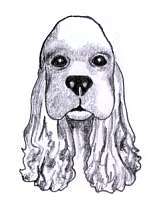 |
|
 |
 |
|
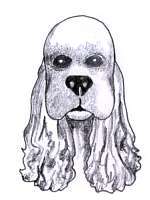 |
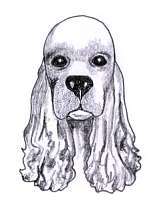 |
|
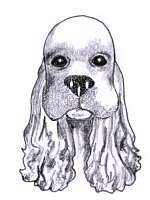 |
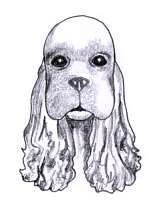 The nose is too small. |
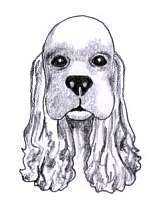 The ears are set too high. |
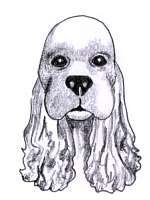 There is too much fullness in the cheeks. |
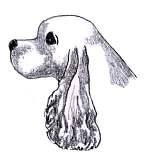 A good profile |
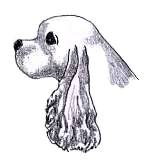 The muzzle is too short. |
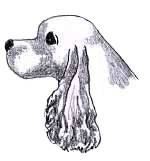 The muzzle is too long. |
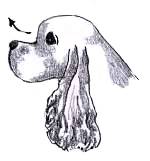 The nose turns upwards. |
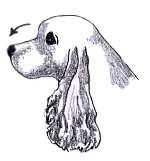 The nose is turned downwards, creating a roman nose. |
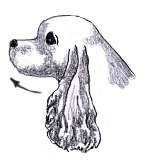 Insufficient depth of muzzle showing weakness. |

